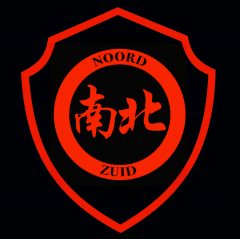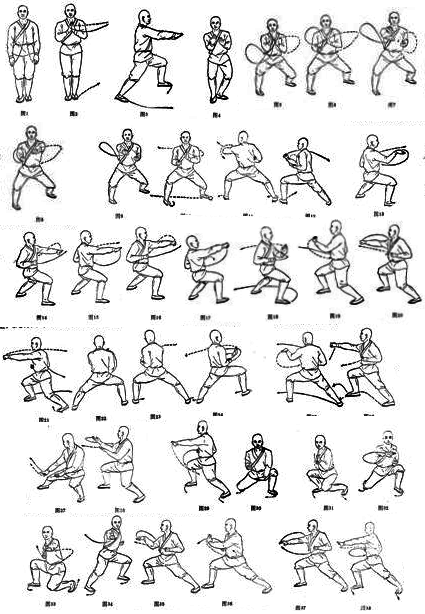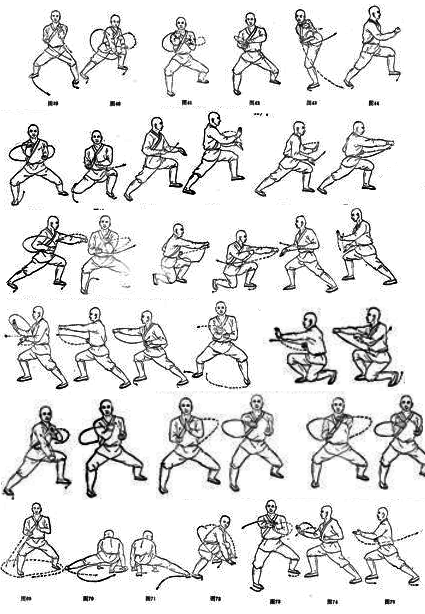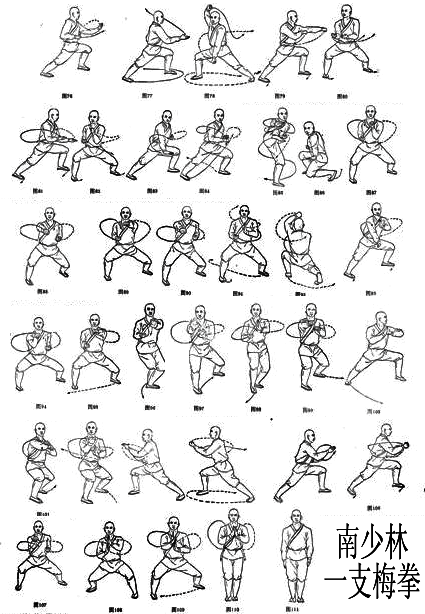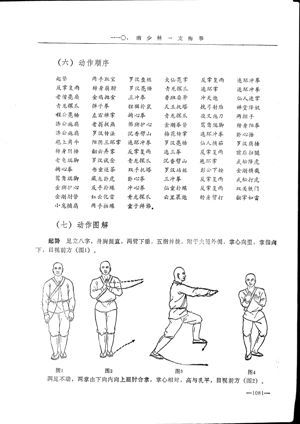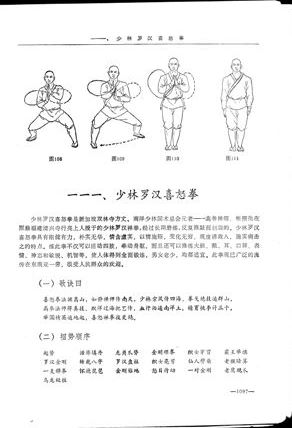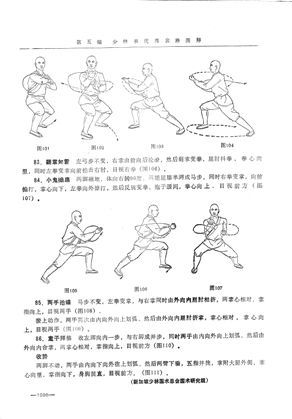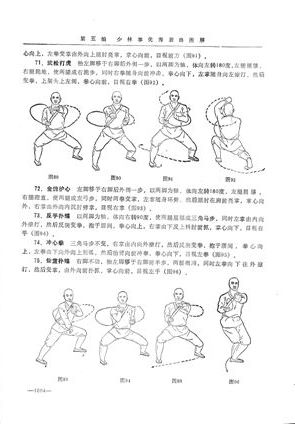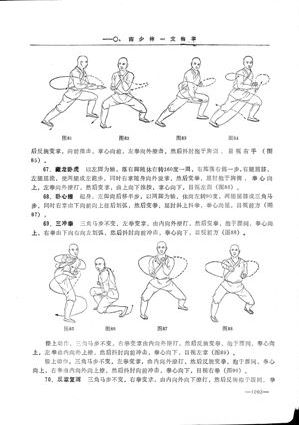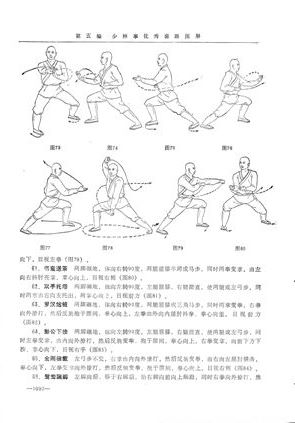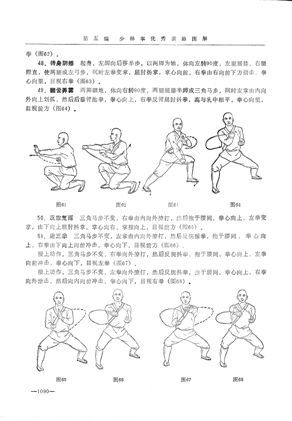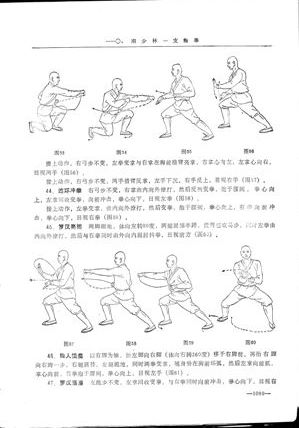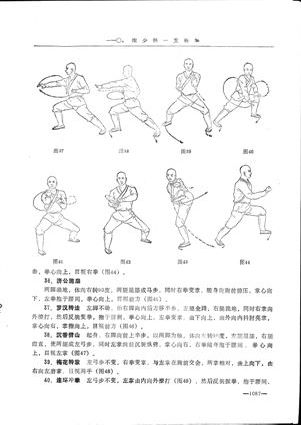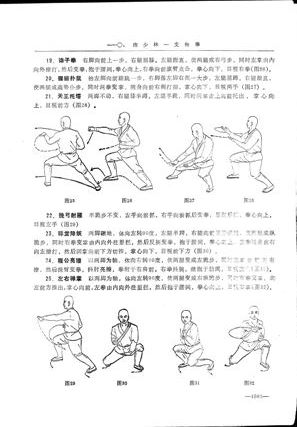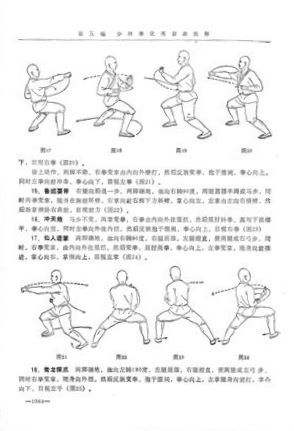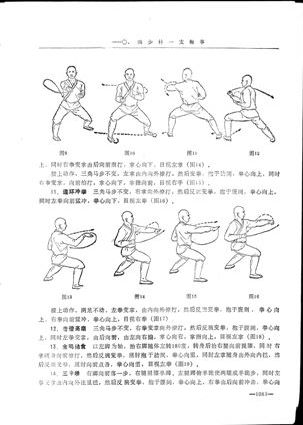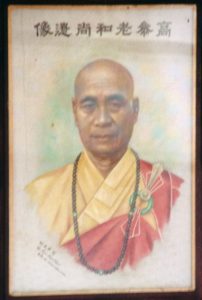 Sek Koh Sam (释高参Shi Gao Shen) 1886 – 1960
Sek Koh Sam (释高参Shi Gao Shen) 1886 – 1960
The life story I present here has been reconstructed from many different sources. Fact is that his course of life was filled with mysteries; the story above is most likely full of mistakes and inconsistencies. So if you have any additional information, including anecdote, to give me (being legend or fact), or wish to correct some errors, please do so! All mistakes are mine: please forgive me.
He was a mysterious man, not even his disciples knew a lot about his life and background. It is also tradition not to ask to much about the life of a Buddhist monk, especially the life he had before becoming a monk.
When he was alive, nobody talked about these things and nobody asked him about it. It has been said that is name was Zhen Hechang, others say Xue Baochang and still others say his name was Lin, given name unknown. His real name was difficult to find, but he indeed had the family name Lin (林) before he became a monk. His given name was Ah Hoong (亞鴻Ya Hong) and another name was Dien Pah (天豹Tian Bao), and he had the nickname of “Fei Tian Bao 飞天豹”, which means Flying Leopard.
He was born on the 27th of December 1886, and his hometown was Hailou Village, Lingtou Town, Northern Gate Outskirts, Huian County, Fujian Province, China. 福建惠安北門外嶺頭.
There were four brothers in his family, and he was the second son. Master Gao Can was a kindhearted person from a young age on. He was determined to help the distressed and succor those in peril in his childhood. He was very fond of medical science. During a long period of arduous time, Gao Can had studied many medical books energetically and practiced assiduously. He knew that if he wanted to help the distress, he must weed out the wicked; and if he wanted to weed out the wicked, he must learn martial arts well.
He lost his parents when he was young and grew up with his brother Lin Yajian林亞尖 with which he got on well, and his wife.
When he was13 years old in 1899 he ran away from home without saying goodbye to find the famous body guard named Cao Biao曹彪 (or Cao Bao曹豹). He was a ace escort, an profession in ancient China, who protects others’ properties for a fee. With law and order crumbling in China, escorts were much in demand and Cao Biao’s reputation was good.
Shi Gao Shen learned Wu Zu Quan (Ngo Cho Kun 五组拳) and most likely also Luo Han Quan (Lo Han Kun 罗汉拳 ) vigorously for 3 years and 4 months (time should be until min 1901). He was very proud to have Cao Bao as his master. Cao Bao adopted 5 students and Shi Gao Shen was the top one. Shi Gao Shen also benefited from some extras Cao Biao had picked up along the way; secret weapon and techniques his master had found beneficial to extending both his career and his life.ShiGao Can returned home at sixteen.
Shi Gao Shen traveled to Singapore (新加坡) for the first time to accompany by his elder brother He was making a living as a boatman at the age of 16. After three years his brother died when boating. He was so sad, he didn´t eat for 3 days.
At the age of 18 (in 1904) he returned home and went to the Huian Qingxing Temple惠安清興寺. He had set his mind to confront suffering and help others to escape its clutches. In the Qingxing temple monk Xing Liang (行亮) shaved the head of Shi Gao Shen and Gao Can agreed to enter the monastic way of life. These first steps in the process of becoming a monk were followed by two years in which he had to prove himself capable of following the necessary edicts. Only then he would be allowed to join their ranks. After this he was ordained a monk of the Caodong Buddhist sect.
He was ordained at the Putian Meifeng Temple 莆田梅峰寺 by the temple abbot Wei Jia微嘉. Monk Wei Jia came from Xi Shan Chan Qing temple in Fuzhou 福建州怡山西禪寺.
Gao Can remained at the Qingxing temple for a couple of years.
As he became a Buddhist monk he was given a new, Buddhist name. His name was from now on Gao Can, or Shi Gao Shen (Sek Koh Sam). ‘Shi’ is short for Shijiamouni 释迦牟尼 which is the Chinese transliteration of the Sanskrit ‘Sakyamuni’. And Sakyamuni was the original name of the first Buddha, before he became an enlightened being. ‘Shi’ can be translated as ‘Reverend’. In fact when you become a monk you leave your family behind and you are given a new family name: ‘Shi’ . A respectful way of addressing a Buddhist monk is using the word Dashi which can be loosely translated as Great Master. So Reverend Gao Can is sometimes also referred to as Gao Can Dashi.
Almost all sources agree on that Shi Gao Shen studied Chinese Medicine (Zhongyi) under Master Chee Leow in Cheng Tai Mountain Temple. The location of this temple remains unknown. Not clear is when this happened; some say this was during his 6 years of travel around China.
He had a restless spirit and left for the Royal Dutch Indies staying at a sister temple for a year before traveling the country for one more.Returning to China he wanted to seek enlightenment from the four corners of China.In 1912 Gao Can started his travel around China. With four brother monks he set off.
He visited many places in China: Putian, Yishan Mountain, Zhaowa, Wutaishan Mountain, Zhentaishan Mountain, Jiuhuashan Mountain, Huangshan Mountain, Emeishan Mountain and Yuanluoshan Mouintain.
During his travels he not only made a lot of intimate friends, but also called on many Martial Arts experts, thus enriching his knowledge of the (Shaolin) Martial Arts. It is unknown to the public exactly how many styles he studied, but among them are: Hup Gun, Phoenix (Hong Nnan; similar to the Chukka style), White Crane (Peh Hok 白鹤 ), Five animal element styles and the styles previously mentioned. He also studied in numerous temples along the way. What he learned and where he learned it is for the most pas undocumented.
Besides the places mentioned above he traveled also to Shandong Province. It was here that Shi Gao Shen and his companions found themselves in the first year of their trip when they heard of a violent dispute. Two villages with a history of discord were generating enough bad blood for the entire region. Whenever the West village came across a renowned fighter they sensed an opportunity to inflict a defeat on their rivals. They set up a lei tai, a raised platform used for fighting and issued their challenge. Over the course of a lei tai, countless fighters could be injured, some maimed, and an unlucky few might even lose their lives.
West village had secured a lethal fighter, their intention was to inflict a devastating blow on the neighbours they despised.
East Village felt compelled to send their martial artists into battle when challenged by their enemy.
The West village fighter name Tai Hu, literally Lei Tai Tiger, was able to deliver a punch which was said to inflict certain internal injury.
It was in the midst of this violent carnival that Shi Gao Shen and his entourage arrived. The dispute was the talk of the province and the villagers were delighted to find virgin ears to hear the tale. Instead of revelling in the feuding, they felt obliged to resolve it. The villagers did not accept their peaceful intervention; if they wanted to involve themselves in the villages’ affairs they could prove themselves worthy on the lei tai, or leave. They accepted.
That evening the first monk took to the stage. He had years of training behind him and was an accomplished fighter. In the openings minutes his light-footed technique was the more impressive and murmurs could be heard in the crowd as they sensed an upset. But a gap in his defenses allowed one of his opponent’s sickeningly heavey blows to land in his ribs. Momentarily doubled over and defenseless, he was brutally dispatched. The second monk tried and he too was expelled without ceremony. The next day another two monks met the same faith and were struck with such venom they suffered internal injury. The second of them would later die as a result. Shi Gao Shen was the last one to step into the ring.
From the imprecise accounts there are of the battle it would seem that Shi Gao Shen took some punishment in the early stages. To the onlookers it looked as though another holy man was going to go down as he parried and maneuvered in search of his opponent’s weakness. But they underestimated Shi Gao Shen , for he was one of those with the physical and mental ability to change tack during a fight.
From fighting in a conventional style he switched to lohan monkey, incorporating the power of the lohan style with trickery and agility of monkey.
The exact details of the fight are not on record. One story has it that the monk lured Tai Hu into launching a punch, only to collapse down and deliver a telling blow to his opponent’s groin. What is known is that by using his amended technique it was Shi Gao Shen who was standing at its conclusion, and he who ‘owned’ the lei tai.
His victory gained attention but this was not what he was seeking. He only wanted to end the villagers’ battle and he set off on his quest again, now alone.
Wandering through land they considered their territory he was at the mercy of bandits and he was forced to resist attacks.
The worst of these was in Sichuan Province when he was hit by a poisoned dart with only his medical training to save him from an unpleasant death.
But four years into his odyssey, his travels were adjourned. The reason was a monk called Hui Jing慧精 of the Nanhai Puji Temple on Putuoshan Island 普陀山岛, Zhejiang Province 浙江省.
( On August 6 and 7 2001 I visited the Zhejiang Nanhai Puji Temple (Chek Chian Nan Hai Pooi Chee See) on Putuoshan Island. I visited this temple in search of traces that might be left behind by either Reverend Hui Jing or Reverend Gao Can. But unfortunately there was nobody left to remember either of them; the last monks from the Qing Dynasty passed away 3 years ago. All the monks living at this moment in the temple were installed there after the rehabilitation and re-legalization of Buddhism in the beginning of the eighties. Temple records were probably destroyed during the Cultural Revolution, although research is being executed after my request. I would like to thank Reverend Shi Yan Quan of the Putuoshan Fojiao Yiyang Tong (Yangzhi Buddhist Monastery) for his warm welcome and his corporation in this matter.)
Shi Hui Jing likely learned his art in the south of China. Very little, even less than about Shi Gao Shen , is known about him beyond his lineage as a forty eighth generation Shaolin monk. He took only four disciples. Three died before the 20th century reached its mid point, leaving just one guardian of the art; Shi Gao Shen . His martial arts were proclaimed to be without equal. Shi Gao Shen himself had already progressed to an advanced level, so for him to present himself as a potential disciple is an indication of Hui Jing’s ability.
Hui Jing was a highly principled man, and extremely strict master, As with many of the traditional sifus he appeared to have a complete disregard for egalitarianism when it cam to kung fu. Only those possessed of innate and exceptional talent would receive his tuition. Hui Jings demands for unswerving good character and impeccable morality ruled out other who might have expected to find a place in his set.
Shi Gao met the requirements and was taken on as a disciple, although there were worries that he was too strong and his temper too quick. Until his unease was dispelled he decided to provide spiritual teaching only to his newest disciple. Shi Gao Shen would not lean kung fu. Shi Gao Shen secretly watched the training of his master and sihengs and memorized it all. At night he would practice what he had observed.
It didn’t remain a secret for long and Shi Gao Shen had to explain himself. His love of Buddhism and martial arts was deep-rooted and genuine. The fact that was only allowed to learn one had been a major blow. If he would have obeyed his master he would have no chance to learn his martial arts. This dilemma had led him to stray from his master’s directives.
Shi Gao Shen also mentioned the dangers he was exposed to when collecting alms for the temple. Self-defense was a necessity, although he was already more than capable.
Although his nightly activities were unacceptable in its disobedience it did held a positive in the dedication in revealed.
Shi Gao Shen was not spared a savage scolding but at its end came a reward. Hui Jing declared he was allowed to learn but he would not have permission to teach anyone else.
It was Hui Jing who would accept Shi Gao Shen as his disciple for martial teachings武事 in 1909. Reverend Hui Jing was of the 48th generation 2nd chamber of the South Shaolin Tradition. For the next eleven years Shi Gao Shen dedicated himself in his entirety to his studies, practicing relentlessly.
Shi Gao Shen practiced Martial Arts in the Shaolin tradition. Nobody is claiming that he was an monk from the actual Songshan Shaolin temple in Henan province. Martial arts were (are?) practiced in many temples in China, since the Shaolin Martial Arts and Buddhism are one. There are many different schools of Buddhism, and Buddhism from Shaolin (Chan Buddhism) incorporates the Martial Arts as a way of cultivating the mind and spirit. So, although the actual teachings left the Shaolin temple a long time ago, Shi Gao Shen Martial Arts can still be called Buddhist style. Therefore many other styles of Martial Art can be called ‘Layman Styles’ (Su Jia Pai). Even the Martial Arts at Songshan Shaolin temple today are a mix of Buddhist and (modern) laymen styles, since after the last destruction in 1928 there were no qualified and fully trained successors left to reintroduce the complete martial arts to the Shaolin temple in the beginning of the eighties of the previous century.
South Shaolin and North (Songshan) Shaolin come from the same sect. Songshan Shaolin in Henan Province is the forefather of Chan. Bodhidharma is the legendary founder of the sect. After Bodhidharma there were another 5 patriarchs; together they are known as the 6 forefathers of Chan Buddhism.
They can roughly be divided into a South school and a North school. There are 5 chambers in the style of Shaolin. These chambers are correlated to the five branches of ‘Chan’. After the fifth patriarch of ‘Chan’, after the founder Damo, the practice of ‘Chan’ went south in China. Huineng惠能, the sixth and last forefather and sixth patriarch, was the leader of the South school.
This style is seen as the second chamber or style/school of Shaolin, also called the second chamber of Shaolin. This school was very prosperous till the beginning of the Qing Dynasty. According to Bodhidharma’s will, sixth forefather Huineng did not ‘hand down the Mantle’ anymore. From then on, the names of the Chan Masters are no longer recorded. It is unknown who started the lineage of Shi Gao Shen or what the lineage names of the monks were.
But the ‘Door to enlightenment’ was passed on to the Nanhai Puji Temple in Zhejiang Province. Master Hui Jing was assumed to be the 48th generation after Huineng.
For 11 years, until 1919, Shi Gao Shen trained the martial arts in the traditional Shaolin tradition. Eventually he was going to represent the 49th generation. Besides Buddhism and the martial arts, he was also taught traditional Chinese medicine and acupuncture. In the end he got superb medical skills and he tried to eliminate disease for everybody in the world and relieve people in need. Hui Jing had only 3 other adopted students and Shi Gao Shen was the only inner circle disciple (入室弟子) of his master. Shi Ga Can took a sacred oath and promised never to disclose the art to the outside world.
Leaving China he took off again this time to South-East Asia. As he travelled through the Dutch Indies, Burma, Thailand and India he would again have reason to be grateful for his martial arts.
Crossing a river one day in Burma, the boat on which he was travelling was stopped by er pah – extortionists who claimed ‘taxes’ for entry to ‘their’ territory. They were demanding payment for the passengers to disembark and did not grant exemptions to monks. As a monk he was rarely in possession of money. He asked the boatman to set off again and dock further downstream, passing the er pah’s territory. They did not agree and followed Shi Gao Shen after disembarking. They surrounded him and a demand for money was made again. With the money not forthcoming they decided to make their claim on his health. It was a mistake ….
As the first man to attack came forward, instead of stepping away Shi Gao Shen moved it. Avoiding his opponent’s strike, he countered with an iron-hard finger which stabbed at a meridian.
To the rest of the gang it was not clear what happened. They saw one of their number move in as they had seen others do before. But this time, in a flurry of robes, the attacker and not the attacked went down. And he went down hard, collapsing as if dead. Most unsettlingly, he did so without any apparent strike; no punch, kick of claw. The collective momentum of the group halted as abruptly as their compatriot’s collapse. They were violent men more used to inflicting blows but they were not afraid of being hit. But to see one of their group taken out so efficiently and with such little effort by this unassuming monk caused a frisson of fear to course through the group. They fled.
Applying his knowledge of remedy, he revived the er pah and send him on his way.
In every place he visited he treated the sick and spread Buddhism, for which he eventually would gain his greatest fame.
He stayed in the Dutch East Indies (now Indonesia) for 20/21 years and became the abbot of the Zhen Yuan Gong (镇元宫Cheng Yuen Kong) temple in Medan. His first master, Xing Liang, had died while abbot of that temple and Shi Gao Shen was asked to replace him.
He was responsible for the construction of nine Buddhist temples in the area of Medan.
Fourteen years into his stay in Medan he asked for permission to spread the Shaolin teachings. He learned so many Martial Arts and considered it to be a waist if he didn’t teach others. His sihengs had all passed away and he was aging himself. It was time for his master’s art to be passed to a new generation. But 25 years earlier he made a vow and he could not break it without his sifu’s blessing.
He send a letter to his teacher in China asking his master for permission to teach, only to find out that Reverend Hui Jing had already passed away years ago.
Some say he broke the promise to his teacher not to teach but actually he wrote instead to one of Hui Jing’s siheng. Only a trusted brother of his sifu’s generation could carry the authority to grand Shi Gao Shen ’s request. Hui Jing’s siheng agreed to Shi Gao Shen ’s appeal. His masters legacy could now be continued.
This is where he really broke the mould and broke the secrecy of the Shaolin Martial Arts. He was already past 50 years before he began accepting students and teach the Shaolin martial arts. This was at the beginning of the second world war (1941).
From then on he started spreading his teachings all over Southeast Asia. The style would become famous under the name Fo Jia Quan (Hood Khar Kun 佛家拳 ), which means Buddhist Boxing or Fo Jia Pai (Hood Khar Pai 佛家派 ), which means Buddhist Style.
As time progressed, students and disciples used different variations or additions to the name Shaolin 少林.
‘Shaolin’; most widely accepted. Standard Mandarin written using the 1958 Hanyu Pinyin system.
‘Sao Lim’, ‘Shao Lim’, ‘Seow Lim’, Siow Lim, ‘Siao Lin’, ‘Siau Lim’; ‘Siauw Lim’, ‘Siu Lam’. All these variations are most likely based on Hokkian pronunciation.
Gao Can Shaolin 高参少林, Gao Can Men 高参们, Nan Bei Quan南北拳, Fo Jia Pai 佛家派 (Hood Khar Pai), Nan Yang Shaolin 南洋少林, and many more. In present day this differentiation might be useful to discriminate the style of Shi Gao Shen from the modern Shaolin coming from the People’s Republic of China.
Shi Gao Shen referred to the art he taught only as Siow Lim Kun (Shao Lin Quan 少林拳). Kun/ Quan literally means fist, but in a martial arts sense it is used to represent ‘style’ or ‘school’.
In Medan he accepted 5 disciples. They are:
释法禅 Shi Fa Can
释成雄 Shi Cheng Xiong
莊慶錦Zhuang Qingjin (nicknamed ‘old monkey’綽號老猴)
莊順來Zhuang Shunlai (nicknamed ‘Basha’ 綽號峇殺)
林金聚Lin Jin Ju
Others mentioned 黃錦章 Huang Jinzhang (maybe lay name of 释成雄 Shi Cheng Xiong?).
The Martial Arts of Shi Gao Shen , though, can be called true ‘Buddhist Style’ (Fo Jia Pai /Hood Gar Pai 佛家派 ) because it was practiced by (Shaolin) monks only. (Although he learned martial arts during his travels in China; one might assume that he people he learned from were not all monks) Shi Gao Shen was the only fully trained and closed door disciple Hui Jing Dashi 慧精大师 , and therefore the only 49th generation successor in this lineage. After 49 generations of cultivating and refining the art, it left the Buddhist society as Shi Gao Shen was the first in the lineage to teach his knowledge to non monk disciples (sujia dizi).
Shi Gao Shen taught many different things to many different students. Although he did taught many students (at least 50 to 100) in Singapore alone), the number of his actual disciples is said to be restricted to 18. In Chinese Buddhism, Sakyamuni Buddha had 18 disciples (of which Bodhidharma was one), so in the Buddhist tradition Shi Gao Shen was said to have had 18 disciples only; that tradition is observed by all true Buddhist teachers. It is my belief that the students were trained in the ‘athletic associations’ set up by Shi Gao Shen and that the disciples were taught in the temples. The disciples were probably also living in the temples.
They were solemnly initiated personally by Shi Gao Shen ; they had to burn and eat the ashes of a “fu” (yellow paper) each signifying obedience, accepting disciplinary actions, not to follow another teacher/master and not to disgrace the name of Shaolin. And if they did leave due to bad conducts or get “kicked-out” of Shaolin by the Master, they were forbidden to use the name Shaolin in the schools they formed nor say they practice Shaolin kungfu.
A disciple differs from a student in one major way. For instance in your ‘athletic associations’ you have 50 students – all learning a standard syllabus and out of the 50 you pick 5 to be personally trained by you. You pass on non-standard forms and techniques to these 5 and you make them go through a “tea presentation” ceremony. These 5 are then you inner door disciples. The other 45 are students of your ‘athletic associations’.
Joining the training under Shi Gao Shen wasn’t as easy as signing up to a modern day school. Shi Gao Shen seeming was more interested in turning people them away than taking them in.:
‘If I decide to teach you I’ll devote a great of time and energy. I’ll expect even more from you in return. You’ll have to train hard and you’ll have to make sacrifices. Are you ready to do that?
There are terms to which you must agree if I am going to teach you. If you accept me as you master you must promise to train seriously for at least three years. Once you enter the temple you will not be allowed out. I’ll make an exepction if you have to work or have family commitments. Then you can go to your job, but you must go there directly from the temple, and come straight back. If you can’t stay in the temple you’ll need to come here before work, report back immediately after and go home only to sleep.
You must be prepared for hard work. And you need to know the benefits won’t be immediate. For the first three months you’ll do only the basics: stance work, foot work, running, punching and kicking. You will learn more after that but don’t be mistaken; it will get harder, not easier’
He would take prospects individually in a room and grill them, enquiring into their backgrounds, their families, their hopes and aspiration.
He would also asses them physically. He would make some exceptions to imperfection if he felt some especially worthy but this flexibility was applied to character. Perceived shortcoming here met with outright rejection.
Then he would take a few days before deciding to accept … or not.
Accepting would mean that Shi Gao Shen would seat himself on a chair and motioned the prospect to kneel on the cushion he placed before him. A temple employee brought in tea and oranges. The prospect set both down at his side, held the cout the cup of tea with outstretched arm and bowed with the word ‘Sifu’, an acknowledgement of the of the role the monk would hold for life. Shi Gao Shen received the tea and placed it at his side. This was repeated with an orange, also ceremonially received. The final bow was performed with his hands empty, palms pressed together. Remaining on the knees and straightening from the last bow, the ceremony was not yet complete. The prospect would now had to swear to oaths that would form the morel guidelines of his new life. They included, among others, vows to develop the good within him and relegate the bad and to be loyal and righteous toward friends, students and his master. Altogether 36 pledges.
Last bow made, the prospect was now officially a disciple of Shi Gao Shen .
The ceremony ended with both bowing in respect to the patriarch of Shaolin at the Bodhidharma altar.
He instructed his students not to eat beef as long as they are active in kungfu ; apparently beef caused the body to be “heavy”.
In Medan he accepted only 5 students.
After the second world war, in 1948, master Song hui (松輝), the acting abbot of the Singapore Shuanglin temple (Siong Lim See 双林寺) asked Shi Gaocan to become the “Zhuchi” 主 of the Shuanglin temple. Zhuchi is the one with the highest position in a temple.
In 1942 Shi Pu Liang was taken to the firing squad after 25 years service as abbot of the temple. The Siong Lim temple suffered collateral damage during the occupation of the Japanese.
After the war local gangsters took over the temple and the surrounding land. Master Song Hui could not handle the situation and asked Shi Gao Shen . Shi Gao Shen was a grand disciple of one of the siheng (senior brothers in learning) of master Song Hui.
Initially he practiced martial arts privately in Singapore. Friend witnessed this and encouraged him to accept disciples in Singapore.
From 1949, aged 63, he started teaching Shaolin martial arts in Singapore.
The disciples of Shi Gao Shen in Singapore who lived and resided in the Shuanglin temple, who were responsible for cooking, cleaning maintenance of the buildings and premises. In addition to these disciples there were many students, however they studied differently and were usually supervised by some of the disciples rather than by Shi Gao Shen himself who was primarily a Buddhist Monk and being busy with other tasks rather than teaching martial arts. Shi Gao Shen had the habit of teaching different things to different people, this created differences amongst the group (so often one school to another teaches different things).
Millions of people there, including both monks and laymen, praised him for his merits. On May 6th, 1954, the Great Master was promoted to the rank of “Fangzhang” Abbot. With thousands of monks, shouts of joy, firecrackers banging and music, Gao Can ascended the throne of “Fangzhang” rank.
All over South East Asia Shi Gao Shen is especially known for the martial arts teachings. Different from what one might expect, he taught different things to different students. This implies that there is not one set curriculum of movements. How it was decided to teach different curriculum is unknown to me, but important factors were the capabilities and talents of the different students. Because his teachings were so different, there are now many schools which, after so many years, all have developed in different directions.
Training with Shi Gao Shen was not easy. Sweat would be broken before dawn did. Warm-ups would involve the disciples running around the temple roofs in the stifling heat with weights strapped to their legs. Then the hard graft would begin. And when training had finished for the morning, it was off to the jobs during the day. After the days work there would be a further three hours with an angry monk. For the blood, sweat and tears were the easy part. The real problem was Shi Gao Shen ’s temper.
Shi Gao Shen had an un expectedly rich and extensive understanding of the more colorful corners of the Hokkien language. And he would unleash it without mercy on the unfortunate cause of his ill-humour.
The abbot’s lack of patience and demanding standards were a challenge to all of his students. But just as difficult were his teaching methods.
A demonstration of steps and stances is a common way to teach martial arts, but while Shi Gao Shen would sometimes perform the moves in an explosion fo swirling robes for the most part he was having none of it. He would sit and direct his disciples verbally from wherever he was perched.
‘Forward stance, grasp with the left, punch with right. NO, WITH THE RIGHT. What’s the point in you being here of you are not going to listen to my instructions? Are you stupid or are you trying to see how far you can push me?‘
The scolding were applied liberally and they were dreaded. Even worse were the times when a mistake resulted in a turn of the head, a dismissive ware of the hand and the quiet but firm order: ‘Go’.
It didn’t get much easier for the studens when they were on the right path. Those hoping an accurate interpretation of his instructions would result in inversely proportionate praise were disappointed. A brisk ‘Yes, that’s right’ was as effusive as it got. Patience did not a appear to be a virtue in the eyes of their sifu. After teaching something, Shi Gao Shen would expect it to be mastered quickly. And once it was taught that was it. From then on it was to performed without flaw. Students were taught only once.
Anyone thinking himself lucky to see Shi Gao Shen begin meditation during practice was also in for a rude awakening. With the master’s eyes closed and his focus apparently elsewhere, it appeared an opportunity to escape a tongue-lashing. This was not the case. Even the smallest of mistakes would still be caught by the fiery monk.
‘Why haven’t you been practicing? Why should I waste my time teaching you if you’re not going to put in any effort?’
Converting the monk’s verbal instructions into physical actions was extremely difficult at the best of times. Some just weren’t capable. The presence of their terrifyingly bad-tempered sifu upped the ante and even students with the capability could go to pieces. The were scolded until they improved or left.
The more fortunate departees went of their own accord. The less lucky were denied the choise. If Shi Gao Shen felt the requisite effort was not being exerted, the disciple would be dismissed and told not to return. Once the door closed it didn’t open again.
Even personal practice was problematic. Shi Gao Shen would not accept that in the course of memorizing a sequence, speed and power might be sacrificed while the movements were drilled into muscle memory. Another scolding would ensue. The disciples soon learned to do their own training on the grounds outside the temple.
When they trained inside it was a sight to behold. Shi Gao Shen had a formidable knowledge of Shaolin and this gave an array of options. When presented with a new student he would size them up and consider their stature. Someone small and nimble might specialize in monkey-style. Another, more powerful and imposing, tiger.
Groups of students or individuals would be stationed in different areas of the temple grounds, each practicing their own thing. Some would have sandbags tied to their legs as they jumped up courtyard walls and ran arounds the temple roof. Others would be in a corner, forearms thudding against one another’s, as they conditioned their limbs. More still would be stationed in the halls and courtyards, practicing their forms.
There were a few universals all knew to follow. Not slacking off was a given. Scoldings were hard enough when they did try to follow instructions. The students also knew not to question their sifu. They were to do what they were told until they were told not to. Answers would either be found through practice or provided by their side; but only when he decided the time was right.
Just importantly, they should mind their own business. They would be taught what was appropriate when it was appropriate, and it would be Shi Gao Shen who made the decision. Sticking their nose into their kungfu brothers’ business was not tolerated.
As mentioned before; Shi Gao Shen taught different disciples different skills. Apparently there are two exceptions to this rule; Yizhimei 一枝梅 and Luohan Quan 罗汉拳 are the only 2 common forms. These are the only 2 sets that can be found amongst almost all the students of Shi Gao Shen , albeit in many different versions. For example, Erzhimei 二支梅of the Penang Sao Lim Athletic Association. Though they vary in their appearance, these to sets can be seen as the core of the Martial Arts teachings of Shi Gao Shen .
But a few aspects almost all the school share. One, and I think the most important one, are the foundations of the Martial Art. As far as I can judge the foundations are practically the same everywhere. This also implies a way of thinking, a theory, closely related to these foundations. A way of reasoning and a guideline for further development, thus causing many separate, but related, schools. This is, what I think, what the Martial Arts of Shi Gao Shen are all about.
Shi Gao Shen showed no inclination to explain his reasons for his segmented teaching. One possibility was likely to have been the time an care he took tailoring his teaching to an individual. His efforts would be undermined by the same student trying to develop his own curriculum.
Tradition and history may also have played a role. The repute of the Shaolin Temple meant it held an allure for those wanting to achieve martial excellence. At times a martial arts swap-shop of sorts, the alumni ranged from generals to rougher sorts whose interest lay in one-on-one warfare. With students not always matching high Buddhist ideals, it is said that knowledge was imparted carefully. The higher arts were supposed to have been taught only to long-term disciples who had proved their genuine intent through the years. It was a practice that endured at Siong Lim. There would be no fast-track.
Shi Gao Shen ’s teaching methods created a diverse and varied training ground, and enabled him to pass on a wide spectrum of knowledge. They also contributed, unintentionally, toward a competitive atmosphere of an unusual kind. That there was a degree of rivalry was unsurprising. The temple was filled with young men fanatically dedicated to learning their art. In such circumstances it was inevitable that some would want to recognized as the best. But making that claim was difficult. There were standard forms that were practiced by all of the students. But when it came to the more specialized they were unable to compare like-for-like with their fellow men.
It wasn’t just that they were taught different forms, they weren’t even supposed to watch the others as they practiced, let alone cast judgement.
But there was a hierarchy. Shi Gao Shen had numerous duties at the temple and he had to be frugal with his time. This resulted in him focusing his attention on a select group, disciples he had identified as the best. Only they would receive extensive personal tuition. The others would still be taken as disciples, they would sometimes be supervised as part of a group, and on occasion they might even be taught directly. But the majority of their tuition would come from the seniors.
For the monks it must have been a surreal experience. Siong Lim is not even a Shaolin temple, but one from the Caodong sect. While Shi Gao Shen was s Shaolin disciple of Hui Jing, he was ordained in Caodong and it was through this lineage that he was invited to Siong Lim. While separate to Shaolin, Caodong is a sect of Chan Buddhism.
The monks had been carrying out their duties in conventional Caodong manner before Shi Gao Shen took charge. Now there were suddenly faced with swarms of kung fu disciple running around the courtyard, jumping walls, hitting bags and breaking bricks. Training was open to them but only one or two accepted the offer. Fortunately many of their number were young men who shared similar backgrounds to the disciples. So despite their different motives for being in the temple, good relations and friendships developed. They lived in the same compound, shared the same facilities, and would ear and chat at mealtimes like any other group of friends or colleagues.
Despite the hardship, learning from Shi Gao Shen was a joy. For all of his fierceness he was revered. Those able to live with his scoldings knew they were his way of raising their levels and that kindness and affection underpinned them. When he wasn’t admonishing them into shape, he treated them with the fondness of extended family and he expected fellow students to view one another in the same vein.
There was also an unswerving belief in the art he taught. It’s a common feature of students to believe their school or system to be the best. In a way they are all right; martial arts tend to share at least some common traits and the style that suits an individual is likely the best for him or her.
What created such appeal in the branch of Shaolin Gao Can taught was it lineage. The fact that it had remained in the hands of so few in its recent history undoubtedly gave it allure. Its breadth and depth made it even more appealing.
With the turbulence inflicted on Shaolin in the first half of the 20th century, finding a fighting monk was not an easy task. Shi Gao Shen was one. When he finally started to teac, it wasn’t for money as he did not charge for lessons. It wasn;t for glory as he had no desire for that. He taught because he loved the art and wanted to propagate it and ensure in prospered.
Just as Shi Gao Shen had clear views on the rights and wrongs of fighting, he had no doubts in regards to its outcome. The art he taught was only to be used when necessity required. But when that time came, losing was unthinkable. He wasn’t the disciple of a millennia old order who would ruin the credibility of Shaolin by allowing his laymen to be punched around. The result was a certain fluidity in Siong Lim numbers. Anyone losing a fight would be summoned by the abbot, whose disgust be palpable. ‘You’ve disgraced me’. Lecture over, the student was now an ex student. This posed a problem. The number of fights involving students was reasonably low But when battle occurred, the result was not always clear-cut, easy victory. Turning up for training, a bruised fighter would be hurriedly ushered out of sight by his more experienced siheng. They knew has battered feature could arouse enough suspicion for, at best, a scolding and extra training; at worst expulsion. Until his warrior markings had subsided the student would need to train secretly, out of sight of their sifu. Training with Shi Gao Shen was indeed not easy.
Later about 10 other schools founded by his students, followed. Many of the associations had the words ‘Sao’ (or Seow) and ‘San’ in them, and almost never use the full term ‘Shaolin’ in the name of the association, only the abbreviation.
It is not certain why this was, but even to this day it means that the schools are easily separated from other branches of Shaolin, although there are exceptions to the ‘Sao .. San’ rule.
Other associations sprung up that can be traced back to his teachings like the Hui Hwa Pugilistic Association 星州惠华国术研究社 , 少南山, 少忠山, 少林得英堂, 少林佛山堂… etc. Some of the students still run martial arts schools, many of them have already passed on and others lead lives in which the martial arts no longer play any role. In the decennia some of these associations have closed due to lack of financial support and dwindling number of members.
He accepted approximately 50 students and disciples, all of them living in or in the direct vicinity of the temple.
As Siong Lim Temple grew in the number and renown of its disciples so did misunderstanding about their activities. Some were innocent, others more calculated. The earliest weren’t directly related to the martial arts students; it was the monks who came under fire. The problem dated back to the unwanted post war occupiers of Siong Lim. Shi Gao Shen ’s reputation had reached Singapore before he arrived in 1947. The temple’s trespassers did not leave immediately when he appeared and their offensive behavior did not instantly become pure. But they were wary of the new head monk.
His aim was to rebuild the congregation. He evidently believed a united front would better rid them of menace and go further toward achieving harmony rather than a one man martial mission to dispose of the problem.
Faced with the new mass resolve that Shi Gao Shen led, the trespassers were eventually forced to accept defeat, but they did not do so with grace. Their revenge was an attempt to disparage the temple. They spread rumours of womanizing monks from a temple housing secret passageways and traps to abduct and hold hostage their female prey. Based on the tales of an unrelated book the stories were manifestly untrue. Yet they provided compelling gossip.
There was little the temple could do but continue in its functions and attempt to dispel the rumours through good deeds. With the temple open to the public, the lack of tunnels and the like was obvious and easy to disprove, and the whispers gradually subsided.
The kung fu disciples were at the centre of the other main controversy. This contended that they contained gangsters in their number. There was irony in the suspicion as Shi Gao Shen detested the activities of criminals.
Through his tuition, young men who might otherwise have bolstered gang numbers were offered an alternative path. If he felt an existing of past gangster was redeemable, Shi Gao Shen might accept them on the understanding their illicit activities were a thing of the past. But if theirs actions were in the present there would be no place for them in his school.
To prevent erroneous entrym prospective students often required nomination from an existing disciple. Even then, if Shi Gao Shen suspected deception they would be quickly dismissed. It was always possible for one or two to slip through the net and another might succumb to temptation after starting to train. There would be no compromise for either from their sifu. A disciple found to have gangland connections would be out. Even one or two from the favoured senior students left under such a cloud.
Yet to Shi Gao Shen , gangsters weren’t completely without merit. There was one benefit to their existence – practice.
The martial arts of Shaolin are claimed to have developed partly in response to attacks by bandits. Their monks, including Shi Gao Shen , had been able to hone their skills repelling them. While there were no bandits attacking the temple in Singapore, there were enough villains to allow the tradition to continue. In particular, the area in which the temple is housed, Toa Payoh, had yet to be absorbed by the city and was notorious for being home to numerous gangs.
Siong Lim’s disciples were no means allowed to swagger the streets of Singapore picking fights, but if someone needed protected, or a gangster invited a lesson through threats and aggression, they were nor discouraged from providing the necessary tuition.
There were a number of skirmishes involving disciples and gang members as a result. Unfortunately, to those unaware of the temple’s abbot’s attitude, the brawls appeared to be fights between gangsters, instead of the battles against them they really were.
Among the number who misconstrued in situation was a faction in the police force and eventually they came calling. While Shi Gao Shen had no patience for errant disciples, he was fiercely loyal to those who had proved themselves to him. He had no intention of allowing them to be unfairly harassed. It must have been a quiet time for Singaporean crime, for when the police came they did so in numbers. The officer In charge, an Officer Yew, ordered the disciples out. The students nearest to Shi Gao Shen saw his eyebrows furrow and his eyes darken in anger. “Go up the roof.” At the order just under a hundred disciples broke from their training and scurried into the eves of one of the temple halls. As they huddled there, three Buddha statues were on hand to pass judgement of a higher kind.
Shi Gao Shen strode to the temple gates. “What do you mean by his nonsense?” he demanded of the officer.
“You’re housing gangsters,” the officer shot back. “Send them out.”
Shi Gao Shen was furious.
“Don’t be ridiculous. I wouldn’t let any gangster come near the temple and I certainly don’t bring them in. My disciples are trained to defend themselves and others and nothing more.” Shi Gao Shen ’s disdain for the officer was not concealed.
“In any case, there’s no one here today. You can look for yourself,” he concluded, gesturing towards the temple’s gates.
The police entered the temple but, findings the abbot’s claim apparently true, they soon made their way back out. Officer Yew was not happy. He warned Shi Gao Shen , threatening to return and arrest him should he get the chance.
“You have no cause to arrest me,” Shi Gao Shen said. “But instead of trying to intimidate me I think you need to pay more attention to yourself.”
Officer Yew’s eyes widened. “Are you threatening me?” he demanded.
“Not at all,” said Shi Gao Shen . “You are going to face danger in the next few days. I don’t know what, but you need to take care.”
Made without any suggestion of malice, the officer found the warning unsettling. As his character was inclined, he compensated for his discomfort with aggression and eyeballed the monk belligerently before storming off.
Four days later he was back, this time unaccompanied. Shi Gao Shen found him waiting politely in the temple. His attitude when he addressed the abbot was much changed. He began by apologizing for his previous behaviour, taking Shi Gao Shen by surprise. The apology was accepted, but still Officer Yew remained where he was. “Thank you, Shi Gao Shen .” He bowed his head and when he continued he was even more hesitant than before. “But I was hoping you would also be good enough to let me show you my true character.” He stopped, looked down for a moment and when he brought his head back he asked to be allowed to join as a student of Shi Gao Shen . The request was a bigger surprise than the apology. “Could I ask what’s brought about such a change?” Shi Gao Shen asked.
Offiver Yew then explained the events of the previous day. He had clashed with a triad, with whom he had had prior run-ins, and been forced to flee when the man pulled out a gun. While escaping, one bullet had come perilously close to hitting him and he been unable since to banish Shi Gao Shen ’s warning from his mind. Shi Gao Shen paused in thought at the end of the officer’s tale. The policeman waited for him to speak.
“Officer Yew, I will admit that I was not impressed with your character when I met you and while your scare has moderated your excesses I doubt you are an altogether changed man. However, I’m willing to give you the benefit of the doubt. I don’t intend to make you a disciple but I will teach you as long as you agree to abide by my rules.” With his acceptance Officer Yew became the first policeman to enter the auspices of one of Shi Gao Shen ’s schools. He did not become a senior student and he did not attain any importance as a martial artist. But other officers followed his and their presence put to bed rumours of gangsterism in the temple, a repayment of sorts for the magnanimity of the abbot. Their influence would also come to the assistance of one of his disciples at a later date.
The numbers of prospective students grew too large for the facilities at Shuanglin to accommodate.
In the summer of the 1954 Shi Gao Shen founded the Singapore Sao Hua San (Shaolin Chinese Mountain) National Arts Association 少华山国术健身社, which opened up a new way propagating Chinese Martial Arts in Southeast Asia. It was opened by a group of senior students.
It was the first school outside the Shuanglin temple where Shaolin Martial Arts of Shi Gao Shen were practiced. The school is now located at 276B MACPHERSON RD. It was the first of 5 schools that were commissioned by Shi Gao Shen himself, although, while he sanctioned them, he limited his own tuition to the temple.
He also founded the Seow Tin San Athletic Association 少雄山國術健身社 in 1954.
On 16 September 1954 the third successful renovation of the Shuanglin temple was completed with a big celebration.
In 1955 Shi Gao Shen had already passed 70, his hair was completely white, but still the traveled to Malaysia after being asked to restore Shuanglin’s sister temple Penang Shuang Qing temple (Penang Siong Kheng See 摈城双庆寺 ) on 59 Jalan Perak in Penang.
Allowing branch schools to further permeate the art was an extension of Shi Gao Shen ’s desire to bring it to the massed, to preserve and strengthen the branch of Shaolin to which he was duty bound. So it seemed logical to open a school there as well. In order to do so Shi Gao Shen took along with him one his most senior disciples.
The temple is still there and can be found behind the Zhulin Temple, but it has changed a lot since the time of Shi Gao Shen ‘s presence. Sadly there are now no traces of Shi Gao Shen or martial arts left inside the temple grounds.
The arrival of warrior monks was no more common to Penang than it had been to Singapore and on the first two nights large numbers turned up. The third brought less welcome guests – the police.
Kung fu was often associated with triads. This meant that local police might be interested when a new school appeared. Whether it was master or student that overlooked the bureaucratic detail, the fact remained that the necessary registration papers had not been acquired for a new school.
The police made their presence known and their displeasure felt before they left. The situation was not ideal. But heaving literally fought for his life during his marathon quests across Asia, Shi Gao Shen was not unduly disturbed by such minor niggles. His student was less comfortable and wanted to avoid any run ins with the police. The difference in outlook meant it was not long before a displeased monk and his disciple made a return trip to Singapore.
With the help of disciple, Quek Heng Choon 郭逢春, Shi Gao Shen returned to Penang in the middle of 1956. Shi Gao Shen was busy with the problems that came from overseeing a temple renovation. His disciple Quek Heng Choon was teaching and his classes were taught in the grounds of Siong Kheng temple. But long term they would primarily take place at the school he was been tasked with establishing, the Penang Sao Lim Athletic Association 槟城少林国术健身社. Four months later after arriving it was ready, its home a shophouse in the centre of Georgetown. Shi Gao Shen was the sifu but in practice he only taught at Siong Kheng. It was the Chief Instructor Quek Heng Choon who taught at the Association.
The Penang Sao Lim Athletic Association had a Grand Opening ceremony at the New World Park and Shi Gao Shen and all his students incl. monks were there to perform various feats. “One performance by Shi Gao Shen was “contraction” of his bone structures…he was a tall man and in the feat he became quite small, this was a very advanced form of kung fu I was told.” an eyewitness reported.
“A storm was brewing and Shi Gao Shen did a “special” prayer, he had compassion on the huge crowd attending, whether it was coincidence or not the skies cleared; everyone there was able to stay for the whole occasion. Then, there was fantastic kungfu using just umbrellas etc to demonstrate one can use anything as a weapon.”
In Penangs school’s early days the the coaching staff had been temporarily bolstered with the arrival of another Siong Lim student, Boon Kiek. When he left, another disciple, Diong Hor, came to take his place.
Other schools were opened by his students in Penang, and the same structure in the names was used as in Singapore. The art still flourishes in Penang, and all over Malaysia for that matter, until today. Some practice in privacy and behind closed door, other promote the art more openly.
Other schools with the “Shao … Shan” 少…山 name construction in and around Penang:
Penang Seow Chu Sang Association 少慈山体育会
Penang Seow Seet San Health Culture Association 槟城少室山健身社
Persatuan Jasmani Seow Hay San Pulau Pinang 梹城少懷山健身社
Siow Hua San 檳城少華山國術健身社 by Quek Heng Choon
Sao Beng Sun 少明山健身学院 (亚依谈)Air Itam
Sao Hoon San Physical Culture Centre少云山健身学院 (吡叻录) Perak
Sao Hong San Penang 槟城少峯山健身学院
Here a short anecdote from Pei from Penang, whose father was a student of Shi Gao Shen at the time he was residing in Penang:
“Yes, my encounter with the old master (the monk from China):I was just a young kid then, I don’t know his name but my dad asked me to address him as “tse-kung” (grandfather), my dad was a student there. Used to go early in the morning and evening to practice.
My dad came home from practice one day and told my mom: When he first joined SaoLin the old master observed his students during the practice; that’s when my dad got injured (I think either his shoulder or knee). The old master rectified the injury right there on the spot using acupuncture and manipulation. Then he told him that his body built was not suitable for the kungfu they were practising and advised that he used the twin swords instead; since then he taught my dad that.
One day my dad took my mom and me to a temple-like building with a big courtyard to meet with this old master (not the building in Muntri St) (Shuang Qing Temple). I guess he wanted to meet with us. There we performed some rituals and had tea and in the conversation he said when I’m a little older he’ll teach me kungfu too. Unfortunately, before I was “old” enough he passed away. My dad was very sad and he left the twin swords in the Muntri St Bld in memory of him.
I got injured as mentioned and my dad went to the bld. on Muntri St to get help and it was the 5th disciple (the 5th disciple used to live at Muntri St with his wife and children and I’ve met them all when my dad took me there occasionally) who came to our house. I was in pain and had problem breathing and lying across the sofa chair; this “tse-heng” (elder kung fu brother) of my dad pressed on pressure points on my body and that relieved my pain and discomfort. Then I had to take Chinese Medicines for some time. I heard from my dad that the 5th disciple learned alot from the old master.”
At his point Shi Gao Shen used to divide his time between Singapore and Penang.
In 1958 Gao Can initiated the Nanyang Siao Lim National Arts Association 南洋少林国术总会, in Singapore and he himself took up the post of the Chief Instructor, teaching the students in Southeast Asia the orthodox Shaolin Martial Arts. The venue was het Siong Lim temple, Later Shi Gao Shen ’s disciple Quek Heng Choon was invited to become Chief Instructor; he served for a year.
The Association was located at the Shaolin Mansion 54 SOMME RD (near Jalan Besar) after they were asked to leave the Siong Lim temple after the death of Shi Gao Shen . Now located 5 lorong 33 geylang Singapore.
They are one of the oldest Wushu association in Singapore and was well known in the 60’s, 70’s and even 80’s as the headquarters of all Wushu Associations teaching the Shaolin form as taught by the late grandmaster Shi Gao Shen .
Teaching there greatly contributed to promoting the Shaolin Martial Arts and building up the health of many people from different countries of Southeast Asia. It also serves as the headquarters of many, if not all, the different schools opened by Shi Gao Shen ‘s students in Singapore.
Also in 1958 Singapore Seow Tin San Athletic Association was started at Old Thompson Road. This was the fifth and latest school to be commissioned by Shi Gao Shen himself.
星洲少镇山国术体育会成立1958年生林猷和创办
As with his own master, Shi Gao Shen did not practice a policy of equality when it came to teaching. The most talented and hard working received the greatest share of his attention; the others got less. Geography played a further role in his bias. Students from his native province of Fujian had a head start in his affections, and they would benefit for the understanding and use of Hokkian.
Shi Gao Shen ‘s actions contributed to in heightening the unity of the Shaolin students in Southeast Asia, to make making friendly contacts between people and Shaolin students from different nations. To build people bodies and catering to the needs of different people in the society.
The Great Master came from a poor family, he had gone through all the vicissitudes of life, he had scaled mountains and forded rivers, traveling thousands of kilometers to relieve people in need. But at last, beginning of spring he fell ill and failed to respond to any medical treatment. On May the 16th 1960 Shi Gao Shen parinirvanaed (passed away), aged 75.
There was not an obvious cause of Shi Gao Shen ’s death. Supremacy in medicine and martial arts might be able to prolong life but they do not equate to immortality. Old age had caught up with him as anyone else. It was reported that Shi Gao Shen at times suffered complaints he put down to internal injuries from his fight with Tai Hor. His internal energy and knowledge of medicine had enabled him to counter these. But at seventy-three, it was possible he no longer had the strength.
His disciple Quek Heng Choon made his casket at his request.
In the world of martial arts it is not uncommon for there be to contention in the wake of a great master’s passing. Shi Gao Shen superlative knowledge and ability negated debates as to his successor; there was nobody able to justify the claim and it is widely agreed none was named. This didn’t stop debate on which disciple was best in ability or who had been closest to Shi Gao Shen . His disciples Quek Heng Choon, Ong Tion Ann and Tay Eng Guan all claimed to have been the ones to take Shi Gao Shen hands in his last days and comfort him at the end.
His casket was placed in the temple for a period of 7 days for public viewing. It wass during this time that problems started to emerge. The first centred on a disagreement between two factions of followers over where the ceremony should take place.
The situation seemed the have been resolved when an eminent Singaporean monk sought direction from the deceased’s spirit through a bei jiao ceremony. Thousands lined the streets leading to Kuang Ming Hill, where the cremation was held and a fitting conclusion to Shi Gao Shen ’s life appeared to have been reached.
His cremation took place on the 22nd May 1960 and was attended by more 5 to 6 thousand mourners.
After he was cremated, there were some white balls of bones left after cremation (apparently only found in people of very advanced levels of kungfu) and they were sent to different schools in remembrance of him.
There was a final drama to be played out. Prior to his death, Shi Gao Shen had let it be known that he wanted his ashes to be scattered in the Singaporean Sea. But before his wish could be fulfilled the ashes disappeared. There was shock and consternation in the temple and the monk responsible for carrying our Shi Gao Shen ’s request could not be consoled. An investigation was launched but without success. Shi Gao Shen ’s remains could not be found. For almost three months their whereabouts remained a mystery and it appeared he would be denied the dignified send-off he deserved. Then one day, as suddenly as his ashes had vanished they reappeared in the ancestors’ hall. The mystery of their return equalled that of their departure. Speculation suggested that the thief might have been a well-wishes rather that someone intending harm. With some Chinese believing the dispersal of a person’s remains prevents the onward journey of their spirit, it was suspected that guilt overcame traditional thought and compelled Shi Gao Shen ’s vestiges to be returned. A definitive answer at this death would remain as elusive as the details on his life. But with the ashes returned, Shi Gao Shen could be put to rest, his cycle could be concluded and his spirit free to move to wherever fate held.
His memorial tablet was set up in the Singapore Shuanglin Temple.
“Teaching and explaining the method by using my own experience as an example, being magnanimous and tolerant, helping the needy and relieving the distressed will make everybody happy.”
The Great Master always regarded this verse as the maxim of his life. He often economized on food and clothing, raised money to buy medicines and donated them to the poor. He also taught the poor Martial Arts for free, and never thought about fame or wealth. He practiced the Martial Arts to the highest degree, he got excellent medical skill, profound knowledge and noble character, so he was admired and respected by millions of people.
People still cherish the memory of him, the Great Master is immortal! Portraits of Gao Can were hung up in all the branches of the Nanyang Siao Lim National Arts Association for people to remember the Great Master. His student mourned for him, and made a poem for him:
“Gao Can was born in Fujian Province, he had experienced a time of tribulation in his childhood. He left his hometown in tears, traveled across the ocean to get a livelihood. He was proclaimed a Buddhist, then studied the Buddhist Sutra energetically, and studied the Martial Arts and medical science assiduously. His charitable and pious deeds was spreader all over Southeast Asia, and he had performed immortal feats. He worked his heart out in Shuanglin Temple and initiated the Sao Hua San National Arts Association. He taught students in Nanyang Siao Lim National Arts Association painstakingly, and he had students everywhere. His heroic posture was known by all the Martial Arts learners in China. He will go down in history as a shining example in Songshan Mountain.”
Abbott Shi Gao Shen was respected by countless individuals mainly for his Buddhist compassion and medicine, also for his martial arts traditions and pure spirituality.
While his martial arts may have been more headline grabbing, he was renowned for his kindness in Singaporean society, as in China and the Dutch East Indies (now Indonesia) before. He may have had a certain fierceness when imposing discipline on his students and disciples but when it came to the community at large he was more obviously benevolent. The doors to the temples were always open. It there was an accident and someone required bone-setting, he would tend to the break. If internal ailments or injuries needed treatment, he would make an assessment and prepare a herbal remedy. And those without influence had their rights ignored, Shi Gao Shen would intervene quietly with others who held sway. When it came to the time for thanks he would deflect their efforts. From the wealthy a donation to the temple would be accepted. From the poos, gratitude and goodwill to Buddha sufficed. He was a well-versed Buddhist, greatly respected by fellow monks. He was a highly regarded medicinal practitioner, turned to by doctors as well as the sick. And he was a man of compassion. Shi Gao Shen ’s approach – stern in teaching, temperate in life – was a template his disciples tried to replicate. Quek Heng Choon: ‘I used to give three chances: “One, two, three, out!” Everyone can get things wrong, but if you’re doing the same mistake after three explanations, you’re either incapable or stupid.’
Shi Gao Shen life’s is mysterious even to Singaporeans. They were told that he sleeps on the roof top of Shuanglin temple, he was able to leap 10 feet walls etc… And so the legends of Shi Gao Shen must be approached. There are claims he was able to break objects from a distance, projecting his qi through a pointed finger. He was supposed to have been seen jumping the twelve foot walls of the temple on a regular basis.
Quek Heng Choon responded to this: “Rubbish. I lived and trained with him for over ten years. Do you not think I would have seen him jumping over walls?’ But to complicate matters, while disagreeing with the tales, he concurs on some claims of extraordinary abilities. Assessing the ability of a man who never demonstrated publicly has obvious complications. Yet it is impossible, for a teacher leaves his imprint on his students, and some judgement can be made through their passion and prowess.
There can be no doubting the fervour Shi Gao Shen inspired, with schools tracing their lineage to him crossing continents. The reverence in which he was held by his direct disciples can be attested to by the number of those alive who still carry his picture, despite being in their seventies and eighties and their master dead for more than fifty years.
There also seems little room for debate in terms of prowess. With so many styles to kung fu it is common for masters to specialize. One may have expertise in white crane, another praying mantis of monkey. Shi Gao Shen had many students and some of the received acclaim for their skills. Yet the fact that they specialized while he mastered the spectrum is indicative of a superlative ability.
Beyond his excellence in the external arts, Shi Gao Shen ’s long years of learning gave him great depth on the internal. He knew soft qi gong, hard qi gong (used of the iron body techniques), qi gong derived from animal forms and he was a long time practitioner of meditation and much more.
He also knew nei gong, literally translated as internal skilss, which help generate internal energy and can also be used to withstand blows. And he was a master of qing gong, literally ‘ling skills’ used to lighten the body or at least make it more nimble. While the exaggerations of the film industry take thing too far it apparently allows and expert to cross short distances more quickly, jump higher and land safely from greater heights. And of course there was dim mak (dian xue).
While all of the abilities may have been of a science that is debated and not agreed upon there were, for the most past at least, explainable though biophysics. Others were less so, and ranking high among these were his skills of fate reading and invisibility. The ‘invisibility’ needs qualifying. It was not the bandage wrap requiring kind that would provide competition for The Invisible Man. It was more akin to and art of stealth. However, it had greater complexity than an ability to sneak around very quietly or walk very carefully on tiptoes. Whether it was related to qi gong or qing gong isn’t clear, but whatever techniques and abilities were used, Shi Gao Shen was apparently renowned. Quek Heng Choon was adamant that when he wanted he could enter and leave room and buildings unobserved.
Shi Gao Shen ’s fate reading was not based in the martial arts. During his trip around China he learned how to create protective talismans from one of his grandmasters’s sihengs and the fate reading may have been related to his. This ability apparently enables him to read the future and even change people’s destinies. Yet just as impressive was his aptitude to see the past. Whether the vice was gambling, drinking or woman, any disciple straying from his Shaolin oaths remained very wary of their sifu.
One of the last wishes of Shi Gao Shen was that the Shuanglin temple continuous to promote the Shaolin martial arts and that within the temple grounds the Damo Hall would facilitate training. Damo Hall was later reverted to Guanyin Hall and teaching continued in the aforementioned Shaolin Mansion.
The term ‘Yizhimei” 一支梅 is a reoccurring term among the schools emerged from Shi Gao Shen. Strangely enough Shi Gao Shen changed the name into ‘Erzhimei’ when he was in Penang; there are a few different moves as well. ‘Luohan’ is a more general term than ‘Yizhimei’. On the one hand as a set form, but also a style of martial arts. Shi De Qian from Henan Shaolin Temple in China, wrote the history of Shaolin and included ‘Yizhimei’ in the (Shaolinsi wushu baike quanshu) Complete Encyclopedia of Shaolin Temple Martial Arts, volume I & II.
Below a translation of part of the description in the book:
“Yizhimei Quan of South Shaolin temple.
Chan Master Gao Shen , originator of Southern Yizhimei Quan, is responsible for spreading it. According to records in the Boxing Manuals in Songshan Shaolin temple, the source of Chinese Shaolin Kungfu, Yizhimei Quan came from Shaolin temple.
In Jiaqing time of Ming Dynasty, pirates often violated China. Southeast coast. Many times the government ordered the fighting monks of Shaolin temple to go and suppress the bandits. Some of these monks died and others were heavenly injured on their legs. The latter couldn’t return and stayed in the area and started teaching to the locals. Because of their injuries they had to mainly teach arm movements and only a few kicking skills. As a result, later a saying emerged in Chinese Wushu circles called: ‘Southern Punch, Northern Kick’.
Then in Qing Dynasty, a monk and his five students names Jingren, Jingliu and so on left Songshan and moved to the South, traveling through Fujian, Guanzhou, Hainan, Taiwan and Nanyue. And they deeply propagated Shaolin Kungfu. As the years went by the boxing skills from Songshan gradually changed into South Shaolin boxing. After that it spread all over China and became the best Kungfu skill in South China.
Southern Yizhimei Quan is a branch is a branch of South Shaolin Boxing. Yizhimei Quan is the evolution of Shaolin Luohanquan. Gaocan improved Yizhimei Quan over the years by long time actual combat as to make it more consummate. He started teaching in Singapore and over the years the practitioners of Yizhimei Quan numbered over the thousands. It is now famous in South-East Asia and beyond.
The main characteristics of Yi zhi mei quan are:
1. Punch and mind united, deeply distilled,
2. Simply vigorous, couple hardness with softness;
3. Having both offense and defense, suitable for actual combat;
4. Special footwork and punch to all directions.
In the 87 movements of Yizhimei Quan ‘the body shape is like sitting down’ from beginning to end. Therefore the horse-step is very common, just like an old monk sitting in meditation, especially the triangle horse step, just like someone side-sit there, reading books or striking bells. Although there are movements, the range is not so big. The names of boxing skills are usually Buddhist technical terms, for example, Arhat, Buddha, Old Monk, Prostrate and so on. It is thus clear that, Yizhimei Quan, is originated from gestures of monks who sit in meditations, combined with hand and feet movements. It then gradually developed until now.
1. Punch and mind united, deeply distilled.
The unity of punch and mind makes skills and movements, therefore shapes are found. Only have shapes but now power cannot subdue your opponents, so if you want to subdue your opponents you should have power. You can also win even when you are controlled by your opponents, this is the essence of Yizhimei Quan.
With the long time hard combat exercise by the master of Yizhimei Quan and their students it is becoming better. And now there are eyes in every movement, there are divisions in every gesture, there are rhythms in every division, playing in quick rhythm. All the movements are fierce, accurate, firm in offense and airtight, hard as iron in defense. If you use is suitably and properly you can win every battle. As a result of using Qigong, Yizhimei Quan has its deep essence.
2. Simply vigorous, couple hardness with softness
Yizhimei Quan, just like the Kungfu in Songshan Shaolin temple,is not flashy, and every movement is for actual combat, standing in winning the battle against your opponent. When using punching and palm skills of Yizhimei Quan, hands usually roll out, move suddenly and strike hard as the thunder.. So an important point is ‘firm’. Firm makes power, and power makes sub dual. Nevertheless, it is firm but gentle. For instance, when taking back our hands, we should turn outward or inward, using gentle and turning power. Gentle as the virgin, move like the clouds. Gentleness can conserve strength, and then becomes firm suddenly. And firm power makes the punch firmer and more powerful, and as a result the practitioner can be unmatched. This is to couple hardness with softness, using every movement like this, and using wisdom and skills together.
3. Having both offense and defense, suitable for actual combat.
Yizhimei Quan has both offense and defense not only in the whole series, but also in every movement. Whenever we use a skill, we usually hit our opponents’ vital part fiercely, meanwhile we also should be strict on guard against our opponents’ plot. In other words,” if I cannot hit you, I will not let you hit me either’. Just like ‘double palm hit’ and ‘triple punch’ in the series, have both offence and defense. The key is, use one palm or fist to hit opponent’s vital part and put the other near the side of the body as a way of defense.
4. Special footwork, punch toward all directions.
Yizhmei Quan has obvious characteristics in footwork, that is; it has only a few kinds of footwork but each kind is very concise, having the merit that it can adapt itself to changing conditions, pay more attention to defense, use defense to confuse the enemy and attack where the enemy is unguarded. For example, when practicing Yizhimei Quan one usually use the horse-step, triangle-step and bow-step. And one use the horse-step the most. Its merit is that one can stand as a stake, still as the mountain. Though being attacked fiercely, we can’t fall over, nor lose balance, out limbs can’t be seized. Especially, we can use constant defense to confuse the enemy and let him attack recklessly, therefore, we can then attack him and then subdue him. Here are some examples:’ little rabbit uses a fan’, ‘turn over your palm to make rain’ and ‘God picks eggplants’.
In all the 87 movements of Yizhimei Quan, we usually use fist-attacking or palm-attacking as the offence and almost never use kicks. No matter moving forward of backward, dealing with the left of the right, we usually use palm or fist. To attack, spit, tease, grasp, beat, flick, snatch, smash or rub. So that is ‘using Yizhimei Quan to attack all directions’. In fact, we can not only use it to punch towards each direction separately, we can also use it to attack all directions at the same time. ‘No matter which directions my opponent comes from, I can defend. My gesture is like a buried stake, and my body movers and turns like a mill. Therefore, even when 8 opponents attack from 8 different directions together I can use a pair of fists or palms to block’.
These words are the purport of Yizhimei Quan.”
Luohan Quan: Xi Nu Luohan Quan; Angry Happy Luohan Boxing.
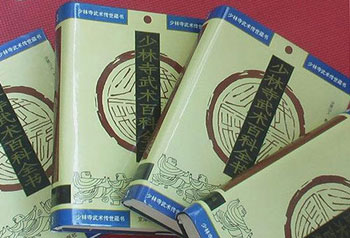 Shi De Qian from Henan Shaolin Temple in China, wrote the history of Shaolin and included Xi Nu Luohan Quan; Angry Happy Luohan Boxing, in the (Shaolinsi wushu baike quanshu) Complete Encyclopedia of Shaolin Temple Martial Arts, volume I & II. Only 18 of the 108 postures were documented in the book.
Shi De Qian from Henan Shaolin Temple in China, wrote the history of Shaolin and included Xi Nu Luohan Quan; Angry Happy Luohan Boxing, in the (Shaolinsi wushu baike quanshu) Complete Encyclopedia of Shaolin Temple Martial Arts, volume I & II. Only 18 of the 108 postures were documented in the book.
On this page and the page are many pictures in, for some people, unusual and strange postures. This is Xi Nu Luohan Quan; Angry Happy Luohan Boxing. It is one of the highest levels of art it includes attributes of emotions and sounds (thus the facial expressions).
This art was said to be practiced by only 4 of the original 18 disciples (of the Shuanglin Temple Singapore), it is said that common students such as those in Indonesia or Malaysia did not learn it. At the time of writing it was said that only 4 people know the entire 108 techniques/postures of the Xi Nu Luohan.
Click here for a pdf file of photographs of Shi Gao Can performing Xi Nu Luohan. I determined the order of the photos based on my own feelings.
Click here for a page which shows them seperatly in random order. Took me over 25 years to collect these.
In fact most students/disciples did not learn the entire Luohan tradition because Shi Gao Can taught different skills to different students. That is why over 30 schools of the Shi Gao Can tradition appeared in Singapore, Malaysia and Indonesia over the years.
Venerable Gao Shen can be transliterated in many different ways, in different Chinese dialects. Mainly in a dialect from Fujian (Hokkian), Guandong (Canton) or in Kejia (Hakka) dialect.
The most frequent transcriptions are: Sek Koh Sam and Sik Koe Chum. Other spellings that I encountered were:
Ven Ko Cham;
Seh Koh Sam;
Sik Koe Chum;
Ke Chum;
Shi Gao Sen;
Koh Sun;
Koh San;
Sik Ko Sum;
Sek Koh Sum;
Sik Gau Sum;
Gaocan;
Shi Gaocan.
Shi Gao Shen , however, was his full Buddhist name pronounced in Mandarin, the standard Chinese dialect and transliterated using the Hanyu Pinyin system. One last problem is that the last character of his name “Shen” can also be pronounced as “Can” and “Cen’, and some seem to prefer that spelling/pronounciation.
